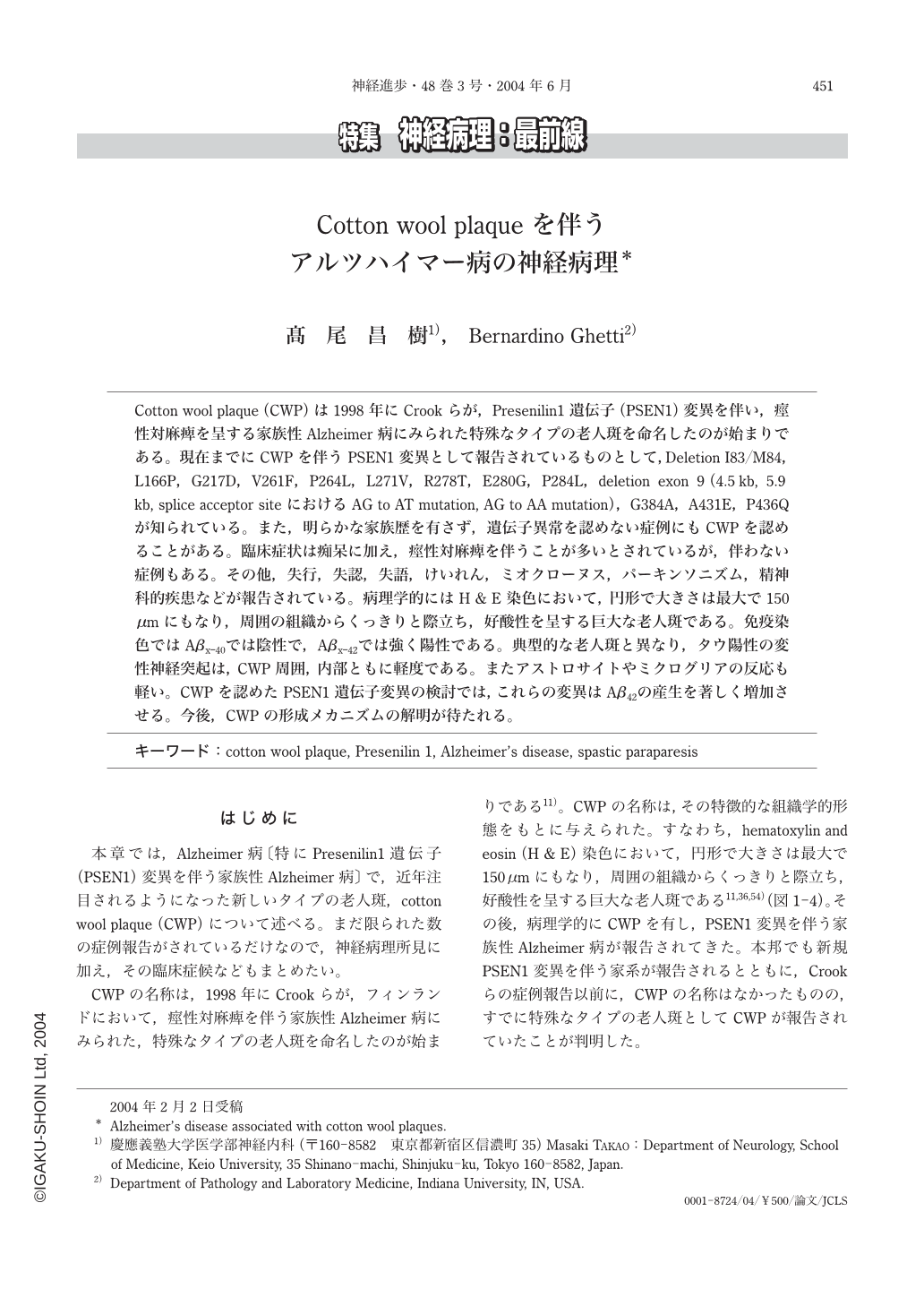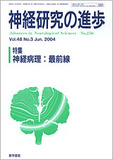Japanese
English
- 有料閲覧
- Abstract 文献概要
- 1ページ目 Look Inside
Cotton wool plaque(CWP)は1998年にCrookらが,Presenilin1遺伝子(PSEN1)変異を伴い,痙性対麻痺を呈する家族性Alzheimer病にみられた特殊なタイプの老人斑を命名したのが始まりである。現在までにCWPを伴うPSEN1変異として報告されているものとして,Deletion I83/M84,L166P,G217D,V261F,P264L,L271V,R278T,E280G,P284L,deletion exon 9(4.5kb,5.9kb,splice acceptor siteにおけるAG to AT mutation,AG to AA mutation),G384A,A431E,P436Qが知られている。また,明らかな家族歴を有さず,遺伝子異常を認めない症例にもCWPを認めることがある。臨床症状は痴呆に加え,痙性対麻痺を伴うことが多いとされているが,伴わない症例もある。その他,失行,失認,失語,けいれん,ミオクローヌス,パーキンソニズム,精神科的疾患などが報告されている。病理学的にはH&E染色において,円形で大きさは最大で150μmにもなり,周囲の組織からくっきりと際立ち,好酸性を呈する巨大な老人斑である。免疫染色ではAβx-40では陰性で,Aβx-42では強く陽性である。典型的な老人斑と異なり,タウ陽性の変性神経突起は,CWP周囲,内部ともに軽度である。またアストロサイトやミクログリアの反応も軽い。CWPを認めたPSEN1遺伝子変異の検討では,これらの変異はAβ42の産生を著しく増加させる。今後,CWPの形成メカニズムの解明が待たれる。
Cotton wool plaques(CWP)are a pathologic alteration initially reported in association with familial Alzheimer's disease associated with a deletion of exon 10(referred to asΔ9)(4.5 kb)in the Presenilin 1(PSEN1)gene. In addition to the initial report by Crook et al, CWPs have been reported in association with other following PSEN1mutations;such as deletion I83/M84, L166P, G217D, V261F, P264L, L271V, R278T, E280G, P284L, deletion exon 10(Δ9)(5.9 kb), deletion exon 10(Δ9)due to AG to AT mutation at the splice acceptor site,deletion exon 10(Δ9)due to AG to AA mutation at the splice acceptor site, G384A, A431E and P436Q. Furthermore, CWPs are found in the individuals of Alzheimer's disease without PSEN1mutations. Most of the affected individuals show early onset of dementia and spastic paraparesis. In addition, they may develop the dysarthria, apraxia, aphasia, ataxia, seizure, myoclonus and Parkinsonism. In some instances, the individuals with CWPs show only spastic paraparesis without any cognitive abnormalities. CWPs are named for their histological appearance in H&E preparations where they appear as round, well-demarcated, eosinophilic lesions measuring up to 150μm in length. They contain wisps of amyloidβ(Aβ)and are immunolabeled using antibodies raised against Aβspecies ending at Ala42. In thioflavin S preparations, they are diffusely and weakly fluorescent. CWPs are quite distinct from classic neuritic plaques in that they lack an amyloid core and a crown of dystrophic neurites. They are also different from the neuritic plaques lacking an amyloid core since the CWP has only a discrete amount of fine taupositive argentophilic neurites. CWPs have a fine tau-immunolabeled neurites and GFAP-immunolabeled profiles. Within in the boundary of a CWP, perikarya of neurons, glial cells, myelinated axons and blood vessels are sparsely seen. Electron microgram showed that CWPs contained numerous neuropil elements and a variable amount of amyloid fibrils. The neuropil elements are small dendrites including spines, axon terminals containing synaptic vesicles and astrocytic processes. Occasionally, paired helical filaments are seen in the dendrites. Round osmiophilic structures deriving from degenerating mitochondria are present throughout the CWP. Bundles of amyloid fibrils are frequently found in the extracellular space and interspersed among neuropil elements. The mutations of PSEN1gene with CWPs are associated with increase Aβ42 production and decrease of activity in Notch signaling. The future study may clarify the pathophysiological function of CWP seen in the Alzheimer's disease.

Copyright © 2004, Igaku-Shoin Ltd. All rights reserved.


